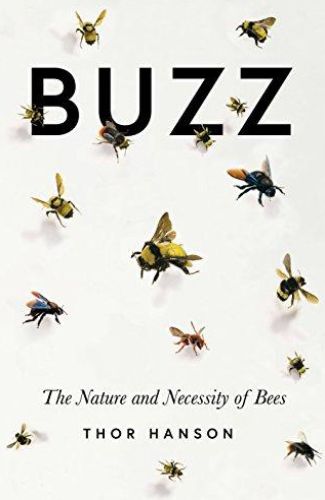Prolific biologist and author Thor Hanson offers a compelling, fact-filled, fun overview of bees, their evolution, their role in nature, and the benefits and threats of their interaction with people.

Who Bees Are
Thor Hanson’s charming investigation into the lives and habits of bees proves delightful and essential reading. Hanson, a conservation biologist, Guggenheim fellow and co-host of PBS’s Nature series American Spring Live, offers reflections on a bee’s exquisite anatomy as well as conversations with entomologists and preservationists. Given the Colony Collapse Disorder of 2006 and ongoing threats to bee habitat, Hanson urges people to become more responsible stewards of this vital natural resource.
Hanson’s readable, engaging overview garnered enthusiastic reviews from multiple sources. The Christian Science Monitor called it, “a loving, infectiously enthusiastic natural history.” The Wall Street Journal said Hanson is, “…an insightful observer of evolution, at his most elegant when digging deep into the science.” And The Guardian called this, “Fun, fascinating and full of engaging pen portraits of scientists and bee enthusiasts.”
History
Hanson begins by noting that early humans raided hives by climbing trees and smoking out bees. As agriculture developed, people cultivated bees. Hanson relates that by the third millennium BC, Egyptians ferried bees up and down the Nile to pollinate plants. Hanson makes a fascinating point: People kept bees long before they tamed horses or domesticated fowl.
No other group of insects has grown so close to us, none is more essential, and none is more revered.Thor Hanson
In mythology, poetry and art, Hanson reports, bees were often messengers from the gods and rivers of honey appear in almost every culture’s concept of paradise.
Bees, he asserts, helped create the remarkable diversity of nature. Their social and hive structures inform architecture, collective decision-making and transportation.
Hanson traces the way bees evolved to become vegetarians, not carnivores, approximately 125 million years ago. Bee species, he reveals, outnumber all birds and mammals combined. Hanson cites how flowers’ nectar feeds adult bees, and the flowers’ nutrient-rich pollen feeds bee offspring. Bees carry pollen to other flowers, aiding reproduction. Hanson reports the fascinating fact that flowers evolved beautiful colors and welcoming scents to lure bees in the quest to be pollinated.
Bee Anatomy
All bee species share antennae, which, the author explains, serve as nose, ears and navigators. All bees have wings, six legs and branched hairs (scopa). Bees’ vision is myopic, but Hanson details how flower colors adapted to the bee’s visual spectrum, which ranges from yellow-orange to ultraviolet – also known as “bee purple.”
For those of us accustomed to life with four limbs and internal skeletons, the bodies of bees seem utterly foreign.Thor Hanson
Hanson raises the conundrum that bees’ bodies seem too big for their wings, but shows that bee wings are super-charged turbines that move with astonishing speed. He may surprise you by reporting that bee wings do not move up and down, but backward and forward, to produce downward pressure similar to helicopter blades.
Hanson reminds readers that not all bees have stingers. Honeybees, he reveals, can sting more than once, but will die if the stinger breaks off. And, he produces another surprise: The vast majority of bee species are solitary.
Crops
Pollination, Hanson asserts, is the single most important contribution bees make to human civilization. For thousands of years, farmers moved hives from one blooming crop to the next to maximize exposure. Industrial farming, he fears, means not enough native bees exist to pollinate thousands of acres in a short blooming period; more cultivated land means fewer natural bee habitats.
Hanson breaks down how renting out bees makes up about half of beekeeper profits. A semitrailer with portable nests can hold up to 10 million bees. Travel stresses bees, he warns, and makes them vulnerable to pathogens. Hanson advises improving and expanding local habitats, so bees can do what they do naturally.
Hanson asserts that bees pollinate 35% of crops and that bee-assisted foods such as nuts and fruit account for 90% of vitamin C consumption and the majority of vitamin A, calcium, folic acid and other essential dietary needs. Bees are efficient, Hanson recounts, in pollinating crops like alfalfa and almond trees.
Die-Offs
Hanson offers the 2006 term “Beepocalypse” for what scientists call “Colony Collapse Disorder” (CCD). Honeybee workers started disappearing, and their affliction was a mystery. Scientists investigated pathogens, climate change and signals from cellphone towers, but, Hanson recounts, identified no smoking gun.
Hanson warns that bee populations are vulnerable to parasites, poor nutrition, pesticides and pathogens. He laments that bees can no longer find sufficient native habitats or sufficient variety in their diets.
In the 21st century, the absence of bees can’t always be written off as a quirk of timing.Thor Hanson
He found that viruses, bacteria and protozoans were not prevalent in honeybee colonies before 2000, but all hives now show traces of them. To help bees survive, Hanson urges people to diversify landscapes, reduce pesticide use and stop moving bees across continents to pollinate crops.
Fascinating Bees
If you don’t find bees fascinating, you likely will after reading Hanson’s rather joyous appreciation. If you already do, Hanson will increase your knowledge and your enthusiasm. He loves bees, loves what they do, and loves their important role throughout history in agriculture and culture. Hanson’s wide-ranging essays and interviews cover all aspects of human interactions with bees, most of which he makes as compelling as he does bee anatomy, bee society and bee agriculture. His easy, happy language makes this complex, multi-layered exposition as accessible to adolescents as it is to curious adults. A wonderful, memorable read.
Thor Hanson’s other books include Feathers, The Impenetrable Forest and The Triumph of Seeds. Other compelling books on bees are Holley Bishop’s Robbing the Bees and Honeybee Democracy by Thomas D. Seeley.






